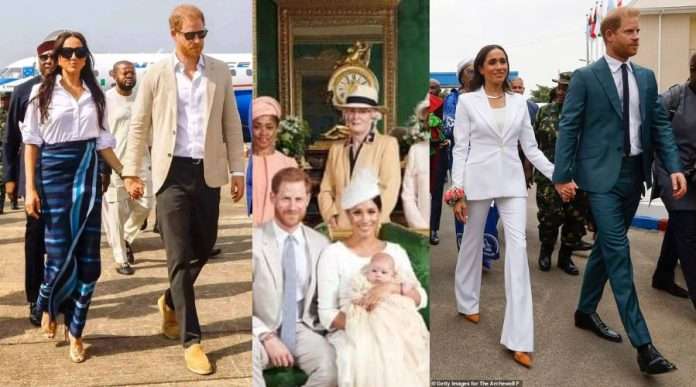Prince Harry and Meghan’s 72-hour visit to Nigeria has attracted a level of publicity Buckingham Palace has been sorely lacking of late.
The photographs of the former royals taking part in a casual volleyball game, accepting flowers from a little girl and visiting local schools to promote mental health awareness made headlines around the world over the weekend.
Prince Harry drew praise over a heartfelt speech about the importance of “acknowledging bad days”, and photographers snapped pictures as he accepted an invitation to sit and throw the ball around with army veterans wounded in battle against the country’s Islamist insurgency.
His wife’s instinctive sartorial choices were also avidly followed by royal and non-royal watchers alike, as was her special connection to the country she called “home”.
The lightning-quick tour of Nigeria was intended to champion mental health for young people and promote the Invictus Games, an international sporting event founded by Prince Harry back when he was still firmly within the royal fold.
Nigeria became the first African country to take part in the games last year, with General Christopher Gwabin Musa OFR, the country’s highest-ranking military official, extending an invitation to the prince this year to help raise its profile.
But it wasn’t a royal tour, it couldn’t be. Not after the duke and duchess’ decision in 2020 to step back as senior working members of the royal family.
After failing to reach a compromise over a hybrid working model, the couple traded in their lofty titles for the chance to earn a private income, swapping the rigid spotlight of the United Kingdom for carefree California.
Four years later, the British high commissioner in Nigeria was at pains to stress this point, releasing a statement that the couple’s visit was in a private capacity and “not an official one”.
“They are not representing the work of His Majesty’s government on this visit,” Richard Montgomery told the News Agency of Nigeria.
It did not prevent the three-day spectacle from making the news locally and within the country Harry and Meghan once considered home.
Some of this attention could not be helped given the stark absences of other senior royals in the public eye in recent months due to illness.
The couple, whether they intended to or not, have demonstrated in their Nigeria stopover, the gap they could have filled had they stayed on as working royals.
And given how small that circle is at the moment, perhaps they have also showed how helpful that would have been.
According to author and former Vanity Fair editor Tina Brown, the visit has drawn recollections of the position the duke and duchess once occupied.
“After all the trashing of Harry … actually when I saw him and Meghan in Nigeria, I had a nostalgia,” she told the BBC.
“I felt this is what could have been, these two — who are enormously appealing to the public, and who are very good at it — were out there in Nigeria looking very attractive and being appealing people. And what a pity it is they’ve gone”
In her view, the couple’s sleek visit was a reminder of the grim realities looming over the slimmed-down royal family and the “Harry-shaped hole in the monarchy”.
The importance of a royal tour
Royal tours by their very nature are filled with pomp and ceremony and are considered to be an important part of making the public believe in the power of the monarch.
One of Queen Elizabeth II’s favourite mantras was that royals “have to be seen to be believed”.
Since medieval times, a monarch’s highly orchestrated trips around the country or (in more recent times) the globe has provided their subjects with proof of life and reinforced the magic of the palace.
The late queen was a firm believer in the importance of these public voyages, embarking on dozens throughout her reign after first coming to the role of monarch while on a royal tour.
As the story goes, she was more than 7,000 kilometres from home on a five-month visit of Africa and Australia when she went up a tree a princess and came down a queen.
But in the 21st century, the pageantry of these events is offset by greater scrutiny from a wary public and a sceptical media throng.
Stephen Bates, the former royal affairs writer for the Guardian, writes that press teams that accompany royals on these visits do so now if three conditions are met.
“There may be some newsworthiness to them …; second, to view the royals at close range in a way that’s not normally possible — to see what they are like in person, maybe even speak to them; and third, to test the water for their popularity,” he wrote for the Guardian.
Last year, King Charles reportedly began planning the largest-ever series of official tours across the United Kingdom, the Commonwealth and other countries.
Those rumours were soon confirmed by Prime Minister Anthony Albanese in February, when he revealed discussions were underway for the king’s visit Down Under.
There had been speculation his trip might fall alongside the Commonwealth Heads of Government Meeting in Samoa in October.
However, the king’s cancer diagnosis and treatment have thrown these plans into question.
Both King Charles III and Princess Catherine have limited their public engagements since announcing they would be recovering from procedures in January.
The king returned to in-person royal duties in late April, after more than seven weeks away from the spotlight, but his public appearances are still being worked out.

















